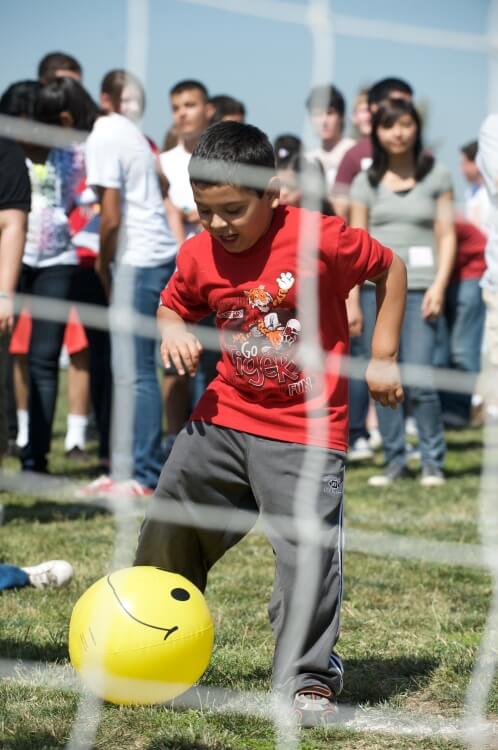PHE America Repeats
10 previously published articles that we think you will enjoy
Reprint 9 of 10
(Originally published – October 25, 2016)
Assessing the skills and physical fitness of students with disabilities can be challenging. Most physical educators are used to assessing general non-disabled students, but many don’t have the know-how and experience of testing and planning activities for students with disabilities (especially students with severe/multiple disability).

Assessment is vital for skill and fitness prescription and for students with disabilities individualized assessment is critical. The following information gives physical educators who teach students with disabilities many practical suggestions for appropriate motor skills testing and fitness programming .
General Guidelines for Successful Skill and Fitness Testing
Motivation can be a problem for many students with disabilities because they lack the intrinsic understanding and concept of giving “100%” effort. Physical educators may need to find extra motivating factors for students to perform at their potential. For example, in the long jump teachers could have students with disabilities reach out and jump to a buddy, jump out for a favorite toy, or jump over a colored rope. Students could also reach for a ball or toy during sit-ups and Sit & Reach tests or listen to their favorite music on a treadmill test for motivation. Motorized treadmills are excellent for cardiovascular endurance training and testing because they provide a “steady pace.”
For attention deficit issues, more verbal and physical cues may be needed, shorter periods of on-task time, and/or more frequent task changes.
Students who use a wheelchair may benefit from the following suggestions:
- Over heating should be closely monitored during vigorous activity. Good air-conditioning, wet towels or a mister, and/or having activities intermittently with shorter periods of exertion can help keep the body “cool.”
- Ensure all bathroom needs are met before exercising.
- Straps may be applied to improve stability of upper body, legs, and/or arms. For example, a student with spinal cord injury trying to throw a ball for distance may need the waist, chest, and the opposite arm strapped down to improve stability as well as safety from falling out of the chair.
When obtaining weight measurements, the educator could hold the student and weight both together, then subtract the weight of the carrier.
When measuring height, consider having people with disabilities lay down on a mat instead of standing.
Gloves, kneepads, and braces may need to be used to avoid injuries.
Treadmill tests should use a full face mask for more natural breathing.
Give people with disabilities more attempts so they can understand/learn the task.
Pictures of skills being performed may be needed along with demonstrations, physical shaping, sign-language, jesters, or computerized communication devices.
Use of visual and physical cues for starting/stopping may be needed.
Several practice sessions should be scheduled prior to the actual test day.
Use a peer to help with:
- skills demonstration
- pacing
- guide tether
- encouragement
- counting
- timing
- stability
Extra “spotters” and thicker or more gymnastic mats can be helpful.
Students with respiratory conditions may need testing indoors with a longer warm-up and they should take medication 30 min prior to activity and be properly hydrated.
Changing Tests Around
Be creative with your testing protocols and test items. You can create your own criteria-related test items from norm-based tests. For example, instead of the “Sit-Reach” test for a student with cerebral palsy, teachers can determine if the student can or cannot touch his or her nose, head, or subscapular for flexibility.
For students with Autism or Intellectual Disability performing the Pacer test, teachers could assess the students’ ability (unassisted or assisted) on specific skill requirements such as: can they line up on the starting line, run to the opposite sideline and back, or how many times they can react (one, two, or three) correctly to the pacing signals? Although, comparable flexibility scores or cardiovascular capabilities are not being tested, skills to perform the test are being evaluated, thus giving some means for assessing improvement and program planning.
You can also count how many successful attempts a student is able to perform for the skill, take the exact time to accomplish the skill, and/or measure the exact angle and distance achieved. Numerical values can be given for almost any skill.
In general, self-comparison on improvement is more appropriate than comparing the student who has a disability to non-disabled students or national standards. Consider mixing and matching skill test items from different assessments such as using the “reaction” test item from the Bruinink-Oseretsky test of motor proficiency, “grip” strength test item from Project Unique Physical fitness test for the disabled, and “block staking” fine motor test from the Denver developmental screening test II.
Creating the best test items for the unique characteristics of students with disabilities will help highlight their abilities and provide skills to work on for Individual Education Program (IEP).
Cardiovascular Evaluation Adjustments
Normal guidelines for predicting Target Heart Rate Zone (THRZ) is to subtract age from Heart Rate Maximum (HRmax) of 220, then multiply 65 to 85 percent for the range. However, for students with disabilities the VO2 max values are typically lower than in the normal population and therefore a lower THRZ may be needed. Further, know what medication your students are taking because it can affect heart rate response at rest or during exercise.
Suggested adjustments:
- Individuals that are only using their arms HRmax: 200 – (age) = ??
- Intellectual Disabilities HRmax: 190 to 210 – (age) = ??
- Spinal Cord Injuries HRmax: 180 – (age) = ??
- Quadriplegics HRmax: 130 to 140 – (age) = ??
- For students with severe and/or multiple disabilities, increasing the heart rate 20 to 30 beats per minute above resting values would be an excellent THRZ.

Individuals with Disability Education Act & Assessments
The law requires a minimum of two types of tests to be administered, such as (a) a norm based test (e.g., Physical Best and Individuals with Disabilities), and/or (b) a criteria based test (e.g., I CAN).
An informal observation should also be administered during a regular PE class, looking for cooperation skills, interactive ability, emotional behavior, and on-task time.
According to the law the following must be performed “by a qualified person” (i.e., PE teacher)
- Assessment data collection
- Interpretation of the results
- Writing of the IEP goals and objectives
Special education teachers, counselors, and/or diagnosticians should not be assessing, determining placement, services, and writing IEP objectives for physical education.
In general, scoring two standard deviations below the mean, two to three age levels behind, and/or does not have the ability to interact in a “normal” PE environment would result in some form of intervention.
Assessment before participation is important for the following reasons:
- Safety
- The development of goals and objectives
- Placement and services
- Equipment needs
- Instructional planning
- Building self-confidence for teachers and students when goals and objectives are accomplished
Physical Educators should answer these questions prior to selecting assessment instruments:
- What skills are of interest to the student with a disability?
- What skills are also the parents’ interests?
- What skills are other students doing?
- What skills does the PE teacher want to assess?
- What skills would the parents like taught?
- Is the assessment testing what I want it to test?
- Is the test valid and reliable?
- Does the test have ecological value?
- Is this an appropriate assessment given the disability, age, sex, and behavior?
- Is the assessment going to help write the (IEP)?
- Is this assessment test going to help the student receive special services if needed?
- What is the student’s present level of health and are they taking any medication?
- What is the student’s best mode of communication, and any other personal attributes that should be considered?
Things for physical educators to think about during health-related fitness testing
- Testing should be in a natural environment (e.g., during play, outside or inside, grass or turf, competitive or cooperative).
- Limit distractions, limit noise, and limit excess or unused equipment from the environment.
- Plan ahead for personnel, equipment, and become very familiar with the test.
- Explain test questions clearly and understandably to students (physically shaping, physical prompt, demonstration, verbal clues, or pictures).
- Allow the student opportunities to ask questions.
- Allow the student ample practice time.
- Present skills in a friendly, encouraging, playful fashion.
- Testing should not exceed one hour per session.
- Tests should be over several days in different environments (inside, outside, game situation, individual skills).
- Different types of assessments should be used.
- Instructors should be sensitive to cultural diversity
Writing-up the Results
Consider the following:
- Physical educators should have knowledge of the students past and current physical, cognitive, and social abilities.
- Results need to be viewed and evaluated considering the environment from which the test was administered for appropriate recommendations and intervention.
- Assessment should include all professional’s perspectives using an ecological approach in a functional and natural setting.
- Include in the assessment the student’s overall functional abilities, both their strengths and weaknesses.
- Results need to be linked to Individual Education Plan (IEP) goals and objectives.
Assessments Used for Students with Disabilities
A variety of options are available (contact the authors for more information):
- Physical Best: for individuals with disabilities: A handbook for inclusion in fitness programs
- Physical Best: A physical fitness education & assessment program
- The Brockport physical fitness test manual
- Project ICAN
- Special Olympics lead up skills
- Project Active: Physical fitness test battery
- Project Mobility
- Project Unique: Physical fitness test for the disabled
- Denver developmental screening test II (DDST II)
- Peabody developmental motor scales (PDMS)
- Test of gross motor development (TGMD II)
- NCAST feeding & teaching scale
- Battelle developmental Inventory (BDI)
- Bayley scales of motor development
- Brigance diagnostic inventory of early development
- Early intervention developmental profile
- The Milani-Comparetti motor development screening test
- Basic motor ability test (BMAT)
- Test of motor impairment (TOMI)
- Southern California perceptual motor test (SCPMT)
- Kansas test of perceptual-motor dysfunction
- The Purdue perceptual-motor survey (PPMS)
- Sherrill perceptual-motor task for physical education
- Conatser adapted aquatics swimming screening test
- Block perceptual-motor development checklist
- Block perceptual-motor screening for individuals with multiple handicaps
Physical educators should use several of these assessments in conjunction with an informal observation during a normal PE class to establish a comprehensive evaluation of students with disabilities. Using a variety of assessments will capture a more accurate picture thus helping facilitate a more successful intervention. In summary, if you have students with disabilities in your classes we strongly encourage you to take an active role in the planning, development and reporting of their assessments.
